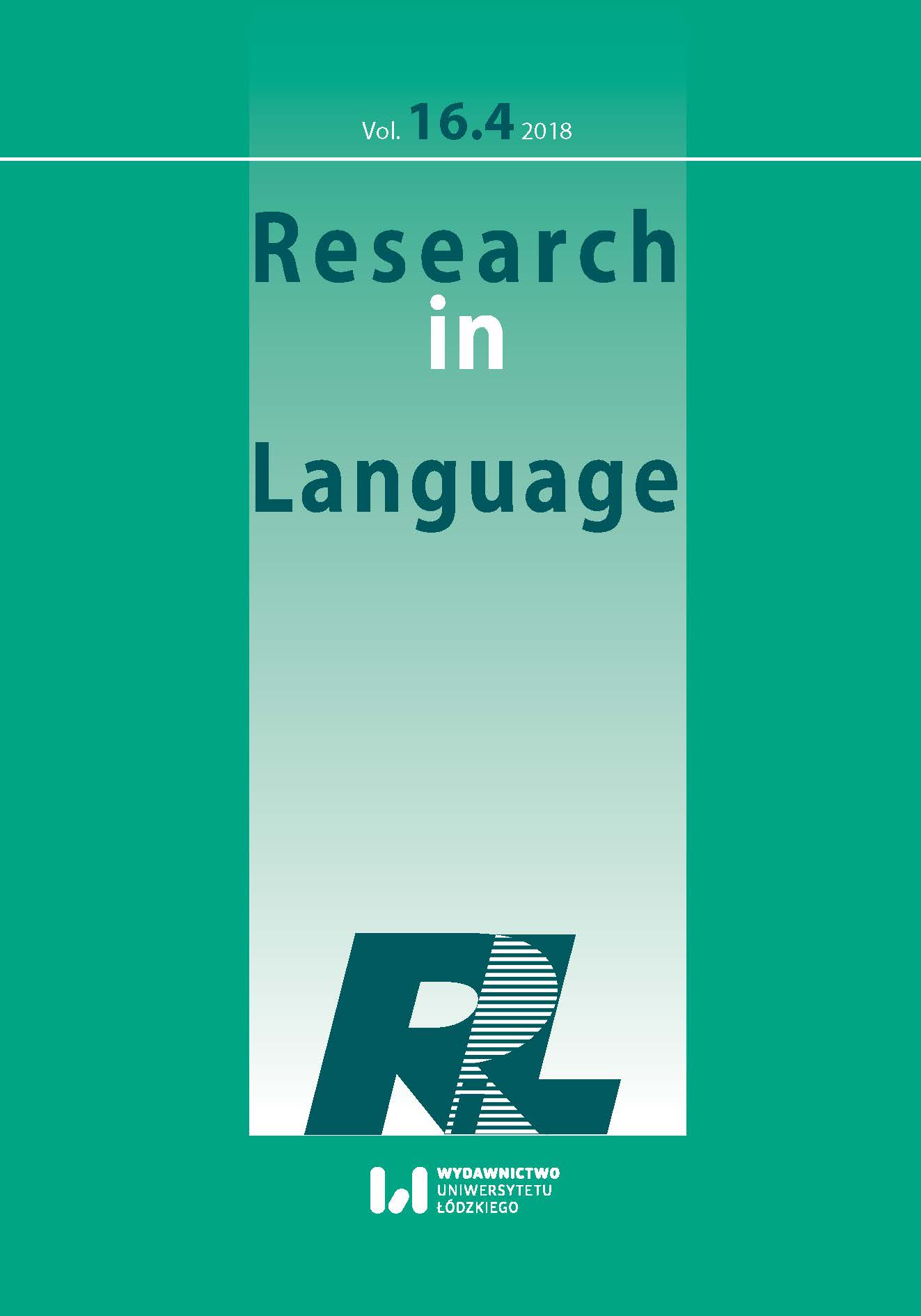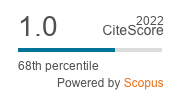The Interplay of Cross-Linguistic Differences and Context in L2 Idiom Comprehension
DOI:
https://doi.org/10.2478/rela-2018-0024Keywords:
idioms, metaphoric competence, cross-linguistic differencesAbstract
The present study investigates to what extent the effect of cross-linguistic differences on L2 idiom comprehension is modulated by the presence of a context. Sixty students of German as a foreign language (L1 French) completed a comprehension test consisting of metaphorical idioms in the L2 that differed from their L1 equivalents conceptually and formally and were presented with or without context. The results show that an increasing degree of conceptual and formal distance as well as the absence of context are generally associated with lower performance in the idiom comprehension test. However, the analysis of interactions shows that the presence of the context was especially supportive for conceptually different items, whereas the facilitative effect of formal similarity considerably diminished with increasing conceptual distance.
References
Abel, Beate. 2003. English idioms in the first language and second language lexicon: A dual representation approach. Second Language Research 19. 329–358.
Google Scholar
Azuma, Masumi. 2009. Positive and negative effects of mother-tongue knowledge on the interpretation of figurative expressions. Papers in Linguistic Science 15. 165–192.
Google Scholar
Bobrow, Samuel A. and Susan Bell. 1973. On catching on to idiomatic expressions. Memory and Cognition 1. 343–346.
Google Scholar
Boers, Frank and Seth Lindstromberg. 2012. Experimental and intervention studies on formulaic sequences in a second language. Annual Review of Applied Linguistics 32. 83–110.
Google Scholar
Boers, Frank, Eyckmans, June and Hélène Stengers. 2007. Presenting figurative idioms with a touch of etymology: More than mere mnemonics? Language Teaching Research 11 (1). 43–62.
Google Scholar
Boers, Frank. 2003. Applied linguistics perspectives on cross-cultural variation in conceptual metaphor. Metaphor and Symbol 18. 231–238.
Google Scholar
Boers, Frank and Murielle Demecheleer. 2001. Measuring the impact of cross-cultural differences on learners’ comprehension of imageable idioms. English Language Teaching Journal 55 (3). 255–262.
Google Scholar
Boers, Frank. 2000. Metaphor awareness and vocabulary retention. Applied Linguistics 21 (4). 553– 571.
Google Scholar
Caillies, Stéphanie and Kirsten Butcher. 2007. Processing of idiomatic expressions: Evidence for a new hybrid view. Metaphor and Symbol 22. 79–108.
Google Scholar
Cameron, Lynn and Graham Low. 1999. Metaphor. Language Teaching, the International Journal for Language Teachers, Educators and Researchers 32. 77–96.
Google Scholar
Charteris-Black, Jonathan. 2002. Second language figurative proficiency: A comparative study of Malay and English. Applied Linguistics 23 (1). 104–133.
Google Scholar
Chen, Yi-chen and Huei-ling Lai. 2013. The influence of cultural universality and specificity on EFL learners’ comprehension of metaphor and metonymy. International Journal of Applied Linguistics 23. 312–336.
Google Scholar
Cieślicka, Anna. 2015. Idiom acquisition and processing by second/foreign language learners. In Roberto. R. Heredia and Anna Cieślicka (eds.), Bilingual Figurative Language Processing, 208–244. Cambridge: Cambridge University Press.
Google Scholar
Cieślicka, Anna, Heredia, Roberto R. and Marc Olivares. 2014. The eyes have it: How language dominance, salience, and context affect eye movements during idiomatic language processing. In Mirosław Pawlak and Larisse Aronin (eds.), Essential topics in applied linguistics and multilingualism. Studies in honor of David Singleton, 21–42. New York: Springer.
Google Scholar
Cieślicka, Anna. 2010. Formulaic language in L2: Storage, retrieval and production of idioms by second language learners. Cognitive processing in second language acquisition: Inside the learner’s mind, 149–168. Amsterdam/Philadelphia: John Benjamins.
Google Scholar
Cieślicka, Anna. 2006. Literal salience in on-line processing of idiomatic expressions by second language learners. Second Language Research 22. 115–144.
Google Scholar
Columbus, Georgie. 2010. Processing MWUs: Are MWU Subtypes Psycholinguistically Real? In David Wood (ed.), Perspectives on Formulaic Language: Acquisition and Communication, 194–212. London/New York: Continuum.
Google Scholar
Conklin, Kathy and Norbert Schmitt. 2008. Formulaic sequences: Are they processed more quickly than non-formulaic language by native and non-native speakers? Applied Linguistics 29 (1). 72–89.
Google Scholar
Cooper, Thomas. 1999. Processing idioms by L2 Learners of English. TESOL Quarterly 33 (2), 233–62.
Google Scholar
Danesi, Marcel. 2008. Conceptual errors in second-language learning. In Sabine de Knop and Teun de Rycker (eds.), Cognitive Approaches to Pedagogical Grammar, 231–256. Berlin & New York: Mouton de Gruyter.
Google Scholar
De Cock, Barbara and Ferran Suñer. 2018. The influence of conceptual differences on processing taboo metaphors in the foreign language. In Andrea Pizarro (ed.), Linguistic Taboo Revisited. Novel Insights from Cognitive Perspectives. Cognitive Linguistics Research Series (CLR), 379–395. Amsterdam: Mouton de Gruyter.
Google Scholar
Durrant, Philip and Alice Doherty. 2010. Are high-frequency collocations psychologically real? Investigating the thesis of collocational priming. Corpus Linguistics and Linguistic Theory 6 (2). 125–155.
Google Scholar
Ferreira, Luciane Correa. 2008. A psycholinguistic study on metaphor comprehension in a foreign language. ReVEL 6 (11). 1–23.
Google Scholar
Gibbs, Raymond W. 1994. The poetics of mind: Figurative thought, language, and understanding. Cambrodge: Cambridge University Press.
Google Scholar
Gibbs, Raymond W. 1986. Skating on thin ice: Literal meaning and understanding idioms in conversation. Discourse Processes 9. 17–30.
Google Scholar
Giora, Rachel. 2003. On our mind: Salience, context, and figurative language. New York: Oxford University Press.
Google Scholar
Giora, Rachel. 1999. On the priority of salient meanings: studies of literal and figurative language. Pragmatics 31. 919–929.
Google Scholar
Grady, Joseph E. 2007. Metaphor. In Dirk Geeraerts and Hubert Cuyckens (eds.), The Oxford Handbook of Cognitive Linguistics, 187–213. Oxford: Oxford UP.
Google Scholar
Hoang, Ha. 2014. Metaphor and Second Language Learning: The State of the Field. TESL-EJ 18 (2). Available from: http://www.tesl-ej.org/wordpress/issues/volume18/ej70/ej70a5/ [Accessed on: January 8, 2018].
Google Scholar
Irujo, Suzanne. 1986. Don’t put your leg in your mouth: Transfer in the acquisition of idioms in a second language. TESOL Quarterly 20. 287–304.
Google Scholar
Kecskes, Istvan. 2000. A cognitive-pragmatic approach to situation-bound utterances. Journal of Pragmatics 32 (5). 605–625.
Google Scholar
Lakoff, George and Mark Johnson. 1980. Metaphors we live by. Chicago: The University of Chicago Press.
Google Scholar
Langacker, Ronald W. 1991. Foundations of cognitive grammar. Descriptive application. Volume 2. Stanford: Stanford University Press.
Google Scholar
Libben, Maya R. and Debra A. Titone. 2008. The multidetermined nature of idiom processing. Memory & Cognition 36. 1103–1121.
Google Scholar
Littlemore, Jeannette, Krenmayr, Tina, Turner, James and Sarah Turner. 2014. An investigation into metaphor use at different levels of second language writing. Applied Linguistics 32 (4). 208–429.
Google Scholar
Littlemore, Jeannette and Graham Low. 2006. Metaphoric competence and communicative language ability. Applied Linguistics 27 (2). 268–294.
Google Scholar
Liontas, John I. 2002. Context and idiom understanding in second languages. EUROSLA Yearbook, 2. 155–185
Google Scholar
Pizarro Pedraza, Andrea. 2013. Tabú y eufemismo en la ciudad de Madrid: estudio sociolíngüístico-cognitivo de los conceptos sexuales. PhD Thesis. Universidad Complutense de Madrid.
Google Scholar
Siyanova-Chanturia, Anna; Conklin, Kathy and Norbert Schmitt. 2011. Adding more fuel to the fire: An eye-tracking study of idiom processing by native and non-native speakers. Second Language Research 27. 1–22.
Google Scholar
Skoufaki, Sophia. 2008. Investigating the source of idiom transparency intuitions. Metaphor and Symbol 24. 20–41.
Google Scholar
Sperber, Dan and Deirdre Wilson. 1995. Relevance: Communication and cognition. Oxford: Blackwell.
Google Scholar
Sprenger, Simone A.; Levelt, Willem J.M. and Gerard Kempen. 2006. Lexical access during the production of idiomatic phrases. Journal of Memory and Language 54. 161–184.
Google Scholar
Titone, Debra A. and Cynthia M. Connine. 1999. On the compositional and noncompositional nature of idiomatic expressions. Journal of Pragmatics 31. 1655–1674.
Google Scholar
Türker, Ebru. 2016. The role of L1 conceptual and linguistic knowledge and frequency in the acquisition of L2 metaphorical expressions. Second Language Research 32 (1). 25–48.
Google Scholar
Yeganehjoo, Masoomeh, Thai, Yap Ngee, Abdullah, Mardziah Hayati and Tan Bee Hoon. 2012. The influence of cross-linguistic similarities on L2 idiom production. The Southeast Asian Journal of English Language Studies 18. 91–107.
Google Scholar
Downloads
Published
How to Cite
Issue
Section
License

This work is licensed under a Creative Commons Attribution-NonCommercial-NoDerivatives 4.0 International License.










